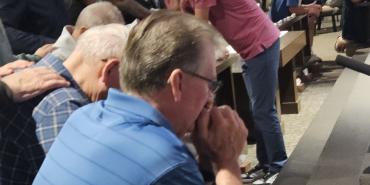The Journey of Lent

I was in high school the first time I noticed an ashen cross on someone’s forehead. One evening, I had arranged to meet a friend, and I arrived at his house just as his family was returning from an Ash Wednesday service. After greeting one another, I noticed the dark smudge on his face. I wondered if I should say anything, but the mark seemed intentional. Curious, I gestured toward his forehead and asked, “What is that for?” He said something along the lines of, “Um . . . I dunno.”
The season of Lent is often shrouded in confusion and misunderstanding. Like my friend, many people have obediently observed the season for years without really knowing why it is important. This lack of understanding has led others to regard Lent with skepticism: it can seem like a hollow and bygone ritual that lacks true meaning. There are also faith traditions that have simply forgotten this part of the Christian calendar altogether.
Yet, the season of Lent should represent a formative period of renewal.
Year after year, Lent invites us to break from our normal routines so that we can refocus our lives on God. It allows us to rehearse the Gospel again: we walk with Jesus to the cross, so that we can find true life.
A Mark of Hope
For most Christians, the season of Lent begins on Ash Wednesday. Ash Wednesday gets its name from the practice of placing palm ashes upon the foreheads of believers as a sign of our repentance and a recognition of our mortality.
On Ash Wednesday, we talk about sin and death. These are two subjects that tend to make us uncomfortable, so our culture often avoids them altogether. In our day and age, people attempt to ignore even the appearance of death: we cover up and attempt to reverse the effects of aging, we outsource the care of our elderly, and we often rush through periods of grief. Despite all the attempts to ignore it, the fact remains: we are all going to die.
“You are dust, and to dust you shall return” (Gen. 3:19b, NRSV). These are the words we most commonly hear as ashes are placed on our foreheads. They certainly aren’t the most uplifting words in the Bible, but we do need to hear them. We need to remember that we are dust: it was only by God’s grace that we were given life. We also need to remember that our sin has a cost and that death will inevitably turn us into dust once more.
Why take time to focus on something that seems so depressing? Because we need perspective, we need renewal, and we need to cling to Christ alone. Recognizing our mortality helps us remember just how deeply we need Christ. Ash Wednesday can open our eyes to the ways we may have been living for temporary, earthly things over the past year. With eyes opened, we can repent of our sins and refocus our lives upon the eternal Kingdom of God.
While serious and reflective, Ash Wednesday is not meant to be disheartening. On the contrary, it points us toward the fresh hope of the Spirit. Even as the ashes placed on our foreheads symbolize our repentance and mortality, the cross they form points us toward our salvation in Jesus Christ.
Even on this first step of our Lenten journey, we have a glimpse of the light that we’ll find at the end of it: resurrection.
Finding Life Through Death
We Christians are indeed a resurrection people! Yet death comes before resurrection, and too often we rush our way toward the empty tomb without first walking with Jesus to the cross. Lent helps us to slow down and intentionally measure that journey—a period of 40 days that we spend walking with Jesus toward death—as we deny ourselves in order to more obediently bear witness to God’s Kingdom.
Lent is a time of refinement and regeneration. Just as Jesus spent 40 days in the wilderness to prepare for His ministry in the world, so we spend 40 days refocusing our lives on God’s mission for us. These 40 days are like a spring cleaning: We clear out the clutter of our spiritual lives in order to listen to God. Having recognized and repented of our sin on Ash Wednesday, Lent gives us the opportunity to reshape the patterns of our lives so that we can live more faithfully.
Observance of the season of Lent can vary greatly from person to person. It may involve fasting from food in order to reflect on God’s provision or abstaining from social media in order to make more time for prayer and Scripture. Alternatively, observing Lent may mean committing to volunteer at a local food pantry or reading a book that is spiritually formative. Whether you choose to fast, adopt a new spiritual habit, or something else altogether, Lenten practices should specifically address areas that will help nurture and grow our faith.
Yet, even as God guides each of us to personal Lenten practices, we must remember that we embark on the journey of Lent together as the family of God. We confess and receive forgiveness together. We lift one another up and guide each other toward faithfulness. Together, we walk with Jesus into death so that we can find true life through His resurrection.
A Witness of Grace
The season of Lent is a vital part of our Christian calendar, because it gives us a specific time to ask, “What are we living for?” Every year, Lent invites us to recognize the ways that we, as individuals and as the Church, have lived for ourselves rather than for God; for this world rather than for God’s Kingdom. By remembering the cost of our sin, we recognize our desperate need for God’s grace. By simplifying our lives, we emphasize that our priority is following Jesus.
As we entrust ourselves more and more to Christ, God uses us to point others toward His Kingdom.
Even though my friend struggled to articulate why he had ashes on his forehead all those years ago, I still remember that he was willing to be marked by his faith. Lent reminds us to live as people marked by the grace and love of Christ. By choosing to live differently than the world around us, we declare that our hope rests firmly in the One who has rescued and redeemed us.
May the Triune God who created us from dust use the unique season of Lent to transform us more and more into ambassadors of Christ’s love and grace for our world.
Travis Caldeira is the pastor of community life at Trinity Church of the Nazarene in Lompoc, California, USA.
Holiness Today, Nov/Dec 2018
Please note: This article was originally published in 2018. All facts, figures, and titles were accurate to the best of our knowledge at that time but may have since changed.




